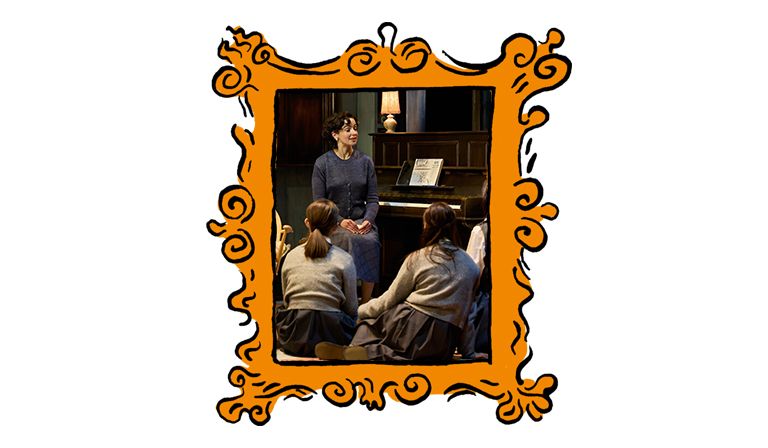We’ve all watched a great play, or a great movie, that doesn’t quite stick the landing. When the central section soars, the comedown of a weak ending is even more of a disappointment.
Two of the biggest recent openings in London—Jez Butterworth’s new play, The Hills of California, and Yaël Farber’s production of King Lear at the Almeida—both left me with this feeling. Yet I’d felt gripped and inspired for two hours before the let-down—so did it matter? For The Hills of California, the answer lies partly in a spoiler included below.
Farber’s Lear, starring Danny Sapani, is the stronger show. Farber is known for the symbolic dreamscapes in which she sets her visions of classic plays: her recent Macbeth at the Almeida was a triumph, with Saoirse Ronan’s Lady Macbeth floating through her nightmares in a stark white boiler suit; her 2017 Salomé at the National a disaster of heavy-handed Old Testament imagery.
Her Lear takes inspiration from South Africa, although the touch is light. There’s a wariness to Sapani’s Lear among his white courtier class—as if their envy speaks to a recent switch of places—and each of his daughters reveals experience in guerrilla techniques of hand-to-hand combat. This is a kingdom that already knows about uneasy transfers of power. Only in a fellow black man, Clarke Peters’s working-class Fool, does Lear find a mirror of himself.
Farber knows the text inside out, and Sapani and his co-stars make it sing. (Occasionally, too literally—Farber loves a cringy sung voiceover.) Fra Free brings a muscular springiness to Edmund, bouncing with self-confidence as he seduces both Akiya Henry’s and Faith Omole’s intelligent, frustrated Goneril and Regan, each primed to erupt against their father and husbands who expect them to flip between competent command and feminine submission at the drop of a military beret.
So why do I find myself agreeing with the Times critic Dominic Maxwell that “the first half is not just one of the best King Lears… but one of the best Shakespeares I’ve ever seen,” only to share his disappointment that the final section “doesn’t quite grip”?
For me, the problem is with Sapani and a failure of character continuity. The best Lears I’ve seen have shown hints of Lear’s irrationality even at his most kingly. (With Simon Russell Beale, it was clear as he abdicated power that he was showing the early symptoms of Alzheimer’s.)
Sapani, by contrast, spends most of the play dignified and competent to a fault. If he’s cruel to Cordelia, it’s because she throws a temper tantrum and he is forced to assert himself by public cameras. He realises far too early in the play that he has made a mistake—the context-free Act One line “I did her wrong”, so often played as a defensive rhetorical question to the Fool, here becomes the weighty climax to the entire scene. Even such moments of self-knowledge, however, are built on dignity. When Sapani’s Lear does eventually crumble, it comes out of nowhere.
If there is a trigger, it is his experience of homelessness alongside Peters’s Fool and Matthew Tennyson’s Edgar. Edgar, streaked with white dust and black muck, feels like refugee from a Neil Gaiman demonology, blown in by the winds under a makeshift palace of plastic sheeting.
Farber has a political point to make about the prevalence of homelessness, both in the UK and South Africa. The moment of sharpest impact is Lear’s recognition that his government has failed the “houseless heads” of his homeless subjects: “O! I have taken too little care of this!” But Farber seems more interested in the breakdown of the external world around Lear than the internal breakdown within.
The Hills of California, too, is undercut by a failure of character development. Butterworth has already proved he can build great characters—not least with Rooster, the caravan-dwelling emblem of riotous England made famous by Mark Rylance’s performance in Jerusalem. Butterworth’s exceptional 2017 play The Ferryman showed us an Irish family with secrets buried in The Troubles. The Hills of California is also a family drama that reveals a socially divisive secret, yet the character who embodies the play’s final tragedy feels thoroughly underdeveloped.
Here’s the spoiler: it’s a play about how mothers scar their daughters, and how daughters survive adolescence and sexual predation. In the 1970s, war widow Veronica is dying; in Act II, we see her running a boarding house in 1950s Blackpool, while she primps and pushes her four daughters into forming a dance troupe. Eldest daughter Joan is the most interesting of the group—sexually precocious, visibly talented—which is why a visiting talent scout takes the wrong sort of interest in her. Is her mother complicit? Is Joan scarred?
We’ll never know, because when Joan arrives back in Act III, she’s a shallow cliché of a washed-up 1970s singer, all sheep-skin coat and Californian drawl, with nothing to say for herself about that pivotal teenage experience.
This lack of depth matters far more than in Lear. There’ll always be rich ideas to explore in a Shakespeare text, even if an actor and director make some weak choices. Of the two shows, readers should book for Lear. But the fundamental problem remains the same. If you don’t feel you’ve gone on a plausible journey with the central character, it’s hard to believe in anything else.
On how not to stick the landing
Two recent stage productions build up wonderfully to... nothing much
February 22, 2024

The Hills of California












